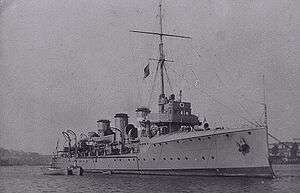Pathfinder-class cruiser
 | |
| Class overview | |
|---|---|
| Name: | Pathfinder |
| Builders: | Cammell Laird, Birkenhead |
| Operators: |
|
| Preceded by: | Forward class |
| Succeeded by: | Sentinel class |
| Built: | 1903–05 |
| In commission: | 1905–19 |
| Completed: | 2 |
| Lost: | 1 |
| Scrapped: | 1 |
| General characteristics (as built) | |
| Type: | Scout cruiser |
| Displacement: | 2,940 long tons (2,987 t) |
| Length: | 370 ft (112.8 m) (p/p) |
| Beam: | 38 ft 9 in (11.8 m) |
| Draught: | 15 ft 2 in (4.6 m) (deep load) |
| Installed power: |
|
| Propulsion: | 2 Shafts, 2 triple-expansion steam engines |
| Speed: | 25 knots (46 km/h; 29 mph) |
| Complement: | 289 |
| Armament: | |
| Armour: |
|
The Pathfinder-class cruiser was a pair of scout cruisers built for the Royal Navy in the first decade of the 20th century. Both ships participated in World War I; one ship was sunk shortly after the war began, but the other survived the war to scrapped shortly after its end.
Background and design
In 1901–02, the Admiralty developed scout cruisers to work with destroyer flotillas, leading their torpedo attacks and backing them up when attacked by other destroyers. In May 1902, it requested tenders for a design that was capable of 25 knots (46 km/h; 29 mph), a protective deck, a range of 2,000 nautical miles (3,700 km; 2,300 mi) and an armament of six quick-firing (QF) 12-pounder 18 cwt guns, eight QF 3-pounder (47 mm) guns and two 18-inch (450 mm) torpedo tubes. It accepted four of the submissions and ordered one ship from each builder in the 1902–03 Naval Programme and a repeat in the following year's programme.[1]
The two ships from Cammell Laird became the Pathfinder class. Four more 12-pounders were added to the specification in August. The ships had a length between perpendiculars of 370 feet (112.8 m), a beam of 38 feet 9 inches (11.8 m) and a draught of 15 feet 2 inches (4.6 m) at deep load. They displaced 2,940 long tons (2,987 t) at normal load and 3,240 long tons (3,292 t) at deep load. Their crew consisted of 289 officers and other ranks.[2]
The Pathfinder-class ships were powered by a pair of four-cylinder triple-expansion steam engines, each driving one shaft, using steam provided by a dozen Laird-Normand boilers that exhausted into three funnels. The engines were designed to produce a total of 16,500 indicated horsepower (12,300 kW) which was intended to give a maximum speed of 25 knots.[3] The scout cruisers soon proved too slow for this role as newer destroyers outpaced them. The ships carried a maximum of 600 long tons (610 t) of coal.[4]
The main armament of the Pathfinder class consisted of ten quick-firing (QF) 12-pounder 18-cwt guns.[5] Three guns were mounted abreast on the forecastle and the quarterdeck, with the remaining four guns positioned port and starboard amidships. They also carried eight 3-pounder Hotchkiss guns and two submerged 18-inch (450 mm) torpedo tubes.[3] The ships' protective deck armour ranged in thickness from .375 to 1.5 inches (10 to 38 mm) and the conning tower had armour 3 inches (76 mm) inches thick. They had a waterline belt 2 inches (51 mm) thick.[3]
Ships
- HMS Pathfinder - launched on 16 July 1904 and sunk by torpedoes fired by U-21 off the east coast of Scotland on 5 September 1914.
- HMS Patrol - launched on 13 October 1904, damaged in action against German battlecruisers which raided Hartlepool in 1914. Sold for scrap on 21 April 1920.
Service
Pathfinder was originally to have been named Fastnet but the name was changed before construction was started.[6] She was torpedoed and sunk by the German submarine U-21 in the approaches to the Firth of Forth on 5 August 1914, giving her the distinction of being the first warship sunk by a submarine.[7]
Notes
- ↑ "Cwt" is the abbreviation for hundredweight, 12 cwt referring to the weight of the gun.
Footnotes
Bibliography
- Chesneau, Roger & Kolesnik, Eugene M., eds. (1979). Conway's All the World's Fighting Ships 1860–1905. Greenwich: Conway Maritime Press. ISBN 0-8317-0302-4.
- Corbett, Julian. Naval Operations to the Battle of the Falklands. History of the Great War: Based on Official Documents. I (2nd, reprint of the 1938 ed.). London and Nashville, Tennessee: Imperial War Museum and Battery Press. ISBN 0-89839-256-X.
- Friedman, Norman (2009). British Destroyers From Earliest Days to the Second World War. Annapolis, Maryland: Naval Institute Press. ISBN 978-1-59114-081-8.
- Friedman, Norman (2011). Naval Weapons of World War One. Barnsley, South Yorkshire, UK: Seaforth. ISBN 978-1-84832-100-7.
- Gardiner, Robert & Gray, Randal, eds. (1984). Conway's All the World's Fighting Ships: 1906–1921. Annapolis, Maryland: Naval Institute Press. ISBN 0-85177-245-5.
- Goldrick, James (2015). Before Jutland: The Naval War in Northern European Waters, August 1914–February 1915. Annapolis, Maryland: Naval Institute Press. ISBN 978-1-59114-349-9.
External links
| Wikimedia Commons has media related to Pathfinder class cruiser. |